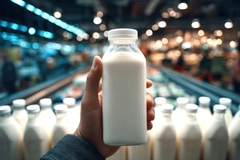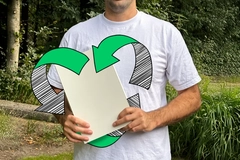Scientists transform plastic waste into soil enhancers for improved farming
10 Jan 2023 --- Scientists from the University of California, Riverside (UCR) have discovered a way to convert plastics into soil additives to improve soil water retention and the aeration of farmlands. The report, “Synergistic and Antagonistic Effects of the Co-Pyrolysis of Plastics and Corn Stover to Produce Char and Activated Carbon,” was published in the journal ACS Omega.
UCR’s Marlan and Rosemary Bourns College of Engineering studied plastics that would otherwise be recycled or end up in landfills by breaking them down into charcoal.
The charcoal captures carbon, benefiting agricultural soil by improving air circulation and water-maintenance. The scientists used polystyrene (PS) and PET plastics, stating they could also fertilize the ground as they naturally break down. However, Kandis Leslie Abdul-Aziz, an author of the study, cautioned that more work needs to be done to substantiate the utility of such char in agriculture.
The UCR scientists have claimed to be devoted to putting waste products such as plastic and plant biomass waste back into the economy by upcycling them into valuable commodities. “We have more of an agnostic approach to plastic recycling when you can throw it in (with biomass) and use the char to better the soil,” the author says.
The findings determined that adding PS or PET plastics promotes the formation of the solid char product with either higher than average pore sizes or surface areas compared to control samples.
 PET and PS plastics, once broken down, may help improve soil quality, according to UCR researchers.Plastic, corn waste and charcoal
PET and PS plastics, once broken down, may help improve soil quality, according to UCR researchers.Plastic, corn waste and charcoal
The study examined how to convert plastic waste into a highly porous charcoal or char with a surface area of about 400 square meters per gram of mass.
Abdul-Aziz and her team began turning plastic waste into charcoal by mixing one of two common types of plastic with corn waste – the leftover stalks, leaves, husks and cobs – collectively known as corn stover. After, the mix was cooked with highly compressed hot water, a process known as hydrothermal carbonization.
The highly porous char was produced using PS and PET, common plastics used in packaging.
“It costs more to recycle used plastic than it costs to make new plastic from petroleum,” says UCR. This suggests that many companies will opt for creating more virgin plastics instead of recycling, causing a need for plastic waste alternatives, such as the one researched by the university.
The surface area of the chars formed from corn stover and PET decreased as the amount of PET decreased, showing a tendency for PET to increase the surface area of the char materials together.
The findings suggest that plastics have a synergistic relationship in producing char precursors with improved porousness but oppose the effects of the activated carbon adsorbent properties.
“It could be a very useful biochar because it is a very high surface area material,” continues Abdul-Aziz. “So, if we just stop at the char and not make it turn into activated carbon, there are many useful ways that we can utilize it.”
Inspiration  Plastic waste in a creek bed at Fairmount Park in Riverside, California. (Image Credit: David Danelski).
Plastic waste in a creek bed at Fairmount Park in Riverside, California. (Image Credit: David Danelski).
The study followed an earlier successful effort to use corn stover alone to make activated charcoal used to filter pollutants from drinking water. In the earlier study, charcoal made from corn stover, activated with potassium hydroxide, could absorb 98% of the pollutant vanillin from test water samples.
The researchers wanted to know if activated charcoal made from a combination of corn stover and plastic also could be an effective water treatment medium. If so, plastic waste could be repurposed to clean up water pollution.
However, the activated charcoal made from the mix absorbed only about 45% of vanillin in test water samples – making it ineffective for water cleanups, according to Abdul-Aziz.
“We theorize that there could be still some residual plastic on the surface of the materials, which is preventing the absorption of some of these (vanillin) molecules on the surface,” she concludes.
Plastics in the environment
Recent research shows that microplastics emerging from agricultural practices could be damaging soil quality and potentially reducing crop production.
Researchers from Staffordshire University, UK, and Adana University, Turkey, found that the number of micro-, meso-, macro-, and mega plastics that were identified in the soil where greenhouse film and irrigation piping was used was about 1.2-times higher than in farmlands that did not use plastic, respectively.
The world is facing an “ocean emergency,” according to global leaders. If current trends continue, the amount of plastic waste polluting the oceans will grow to 29 million metric tons a year by 2040 – the equivalent of 50kg for every meter of coastline in the world, UN secretary-general Antonio Guterres previously told PackagingInsights.
The UCR research demonstrates a way to displace plastic waste that would otherwise harm oceans and farmlands and instead introduce it in soils as a practical solution to the global plastic waste crisis.
Edited by Sabine Waldeck











